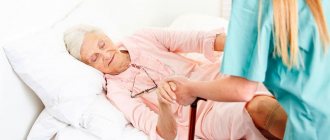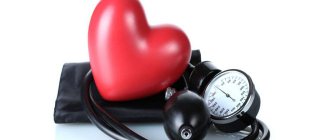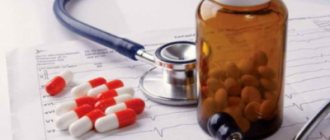Content
What is a stroke?
Complications after a stroke
- Paralysis
- Coma
- Brain swelling
- Aphasia
- Loss of coordination
- Apraxia of walking
- Relapse of the disease - why does it happen?
Who can have a stroke? Predisposing factors
- The main distinguishing features of female attacks
- In men
Precursors of stroke
The main thing is to see a doctor in time
Drugs for stroke
What is a stroke?
The disease is an acute circulatory disorder in the human brain. The attack develops rapidly. It takes from a few minutes to several hours for a person to be seriously injured - sometimes irreversibly. Doctors call the limit of providing effective assistance a time period of 6 hours. After this, the patient will no longer be able to recover if he survives. The consequences of a stroke are the death of brain cells due to oxygen starvation.
The two most common types of stroke are:
- By ischemic type (ischemic) – occupies a share of 75%. The peculiarity of this pathology is blockage of blood vessels or their compression. Damage occurs as a result of the presence of embolism, thrombosis and some other pathologies of the blood, blood vessels, and heart. Mortality rate is up to 15%.
- By hemorrhagic type (hemorrhagic) - occurs in 20-25% of cases. In this type of stroke, blood vessels rupture and bleeding occurs in the brain. Mortality rate – up to 35%.
Very rarely (up to 7% of cases) subarachnoid hemorrhage occurs. Its causes are traumatic brain injury or rupture of an arterial aneurysm (also due to trauma to the patient). In this case, the hemorrhage is directed into the space between the soft and arachnoid membranes of the brain. As a result of such a “blow”, more than half of the victims die.
You can undergo an examination in our clinic at the address: St. Petersburg, st. Bolshaya Raznochinnaya, 27 metro station Chkalovskaya
Complications after a stroke
Paralysis
This complication occurs when the motor center is involved in the pathological process. Most often, hemorrhage occurs in the left hemisphere of the brain, as a result of which the right side of the body is “taken away”. Paralysis can also be left-sided. As a result, the patient cannot contract muscles or make any movements. At the same time, behavior and perception of the surrounding world differ in patients with right- or left-sided paralysis. Often there is a mental disorder (excessive aggression, for example) or thinking.
Coma
This condition can last from several hours to several years. Coma occurs due to damage to the cortex and subcortical substance of the brain, as a result of which all signals are inhibited. In a coma, the patient's breathing and cardiac function are depressed, he is unconscious, and his reflexes are impaired. Some fall into a coma quickly, while others gradually. In the second case, within a few hours:
- the patient yawns frequently;
- general fatigue and malaise are felt;
- pulse changes;
- the body goes numb;
- coordination of movements is impaired;
- limbs lose sensitivity and mobility;
- there is a disturbance of consciousness;
- breathing activity becomes superficial.
Brain swelling
One of the most dangerous manifestations of a stroke. Symptoms include: convulsions coupled with psychomotor excitability, headache, nausea and vomiting against the background of increased intracranial pressure.
Edema is divided into two types:
- Cytotoxic. Brain cells swell due to a lack of oxygen and adenosine triphosphate. As a result, membrane pumps do not work properly, sodium ions penetrate into the cells, and water accumulates.
- Associated with impaired outflow of intercellular and interstitial fluids, as well as blood. Occurs when capillaries are damaged.
Aphasia
Impaired speech and writing ability. May include an inability to understand what others are saying, slow speech, and difficulty remembering and writing.
Loss of coordination
During a stroke, muscle tone and coordination of movements are impaired. As a result, a person cannot move without assistance. The muscles also spasm, as a result of which the patient’s actions are even more difficult, since he is forced to overcome the resistance of his own body.
Apraxia of walking
A person can take steps, but in general the process of walking cannot be controlled.
Relapse of the disease, why does it happen?
Provoking factors for the second and subsequent attacks are atherosclerosis, hypertension, thrombosis, abnormal vascular structure, and diabetes. In addition, patients often harm themselves. Having overcome the first difficulties, they neglect to visit the doctor and follow his recommendations. Many people return to bad habits and do not treat associated pathologies.
Basic undifferentiated therapy
Taking into account the test results and clinical examination data, basic undifferentiated therapy for stroke includes:
- monitoring blood oxygenation;
- prescription of oxygen therapy;
- ventilation support;
- endotracheal intubation for acute respiratory failure and loss of brainstem reflexes;
- lowering blood pressure if diastolic blood pressure is above 120-140 mmHg using the following drugs: perindopril -5 mg per day, captopril - 25-50 ml per day, indapamide - 1.5 mg per day (but such recommendations are not universal for all cases);
- elimination of arterial hypotension with the help of dopamine;
- maintaining blood pressure at an optimal level for the patient, avoiding sudden jumps;
- administration every day of 2-2.5 liters of liquid parenterally, divided into several infusions;
- in the presence of cerebral edema, the amount of fluid administered should be reduced by 300-350 ml;
- infusion therapy is carried out under the control of the level of electrolytes, plasma proteins, and acid-base status;
- administration of insulin, if the blood sugar level exceeds 7 mmol/l, alcohol-dependent patients additionally need to be administered 100 mg of thiamine;
- at elevated temperatures it should be knocked down if the readings are above 37.5°C;
- if signs of infection appear, antibiotics or antiviral drugs are prescribed;
- checking swallowing function and choosing a method of feeding the patient (tube or enteral);
- the earliest possible verticalization (carried out on days 2-4).
Along with basic therapy, neurologists at the Yusupov Hospital carry out measures that help restore blood flow and maintain optimal blood fluidity. For this purpose, the patient is prescribed thrombolytics and aspirin.
You can make an appointment with a neurologist or another doctor at the Yusupov Hospital by phone. The coordinating doctor will tell you about the availability of hospital beds, the cost of treatment and answer all your questions.
Author
Alexey Vladimirovich Vasiliev
Head of the Department of Neurology, neurologist, Ph.D.
Who can have a stroke? Predisposing factors
It is generally accepted that stroke occurs only in older people. However, in recent decades the disease has been rapidly becoming younger. An attack can occur as early as 40 years of age or even earlier.
Main risk factors:
- disturbances in sleep and nutrition when entering a “dangerous” age – over 50 years;
- hypertension;
- chronic heart disease;
- high stress loads at work;
- smoking and alcohol abuse;
- temporary, rapidly passing ischemic attacks;
- high blood cholesterol levels;
- obesity;
- diabetes mellitus (it increases the likelihood of not only the first, but also a second stroke);
- hereditary factor;
- lack of timely hospitalization during an attack and lack of qualified medical care in municipal hospitals;
- trauma (the rarest cause of stroke)
However, symptoms and causes differ between women and men.
The main distinguishing features of female attacks:
- the predominance of the disease is of the hemorrhagic type;
- very long and difficult recovery of functions;
- high mortality;
- high loads on blood vessels during pregnancy;
- Among the main causes are migraines, headaches, and great stress;
- it’s easier to see the first symptoms of an approaching “blow”;
- One of the provoking factors is taking oral contraceptives.
The most pronounced symptoms in women include: weakness, slowness of movement, shortness of breath, wheezing, increased heart rate, blurred vision, double vision, fainting, impaired hearing, pain on one side of the face and body, and unbearable headache.
In men
The main risk factors are impaired blood circulation, blockage of blood vessels, rupture of arteries with subsequent hemorrhage, blood thickening due to various diseases, obesity, diabetes mellitus, lack of physical activity, poor diet and eating disorders, bad habits, severe physical activity, vegetative-vascular dystonia, hypertension .
The main signs of a stroke in men may appear periodically, but go away over time. In this situation, the most dangerous thing is to decide that the trouble is over. After all, most likely, these are just transient ischemic attacks, signaling the approach of a stroke.
With the ischemic type, a man may feel dizziness, severe headache (it cannot be relieved by painkillers), weakness, decreased sensitivity in the limbs and numbness, short-term fainting, and vomiting.
A hemorrhagic attack is expressed by loss of consciousness, a sharp increase in pressure, the face becomes very red, noises are heard when breathing, facial asymmetry is noticeable, and vomiting occurs.
Precursors of stroke
Symptoms before an attack appear within a few days. However, many do not pay attention to them, because the signs of an impending stroke disappear on their own.
How to recognize the proximity of a “blow”? The most important harbingers:
- headaches that appear suddenly and go away quickly;
- weakness unexpected for a person;
- causeless nausea;
- short-term dizziness;
- frequent mood changes.
You also need to pay attention to symptoms such as:
- visual and hearing impairments;
- slow pulse;
- numbness of the limb;
- flushes of blood to the face;
- disturbance of speech function or coordination of movements;
- severe sweating.
If you have these symptoms, you should immediately consult a doctor, as it is still possible to prevent a stroke.
Within 3 hours from the moment of formation of a brain lesion, acute manifestations of a close “impact” occur:
- difficulty swallowing;
- unbearable headache that leads to fainting;
- severe dizziness;
- vomit;
- convulsions;
- breathing problems;
- tachycardia.
At this stage, the victim requires urgent hospitalization. With timely provision of first aid, the likelihood of severe complications will be reduced.
Magnesium (magnesium sulfate)
In experimental studies conducted on models of focal cerebral ischemia, the use of magnesium sulfate significantly reduced the size of the infarction [Izumi Y. Roussel S. 1991. McDonald JW Silverstein FS 1990]. In experimental global cerebral ischemia, the use of MgCl2 24 hours after the initiation of ischemia made it possible to significantly reduce the area of necrosis in the CA1 zone of the hippocampus [Tsuda T. Kogure K. 1991].
A pilot clinical trial of magnesium in 13 patients in the first hours after the onset of ischemic stroke demonstrated the safety of its administration; in addition, the proportion of patients with a good neurological outcome has increased, and the rate of disability has decreased [Strand T. Wester PO 1993. Wahlgren NG 1995]. The results of treatment with magnesium in 60 patients with ischemic stroke not only confirmed the safety of the drug, but also established a significant reduction of 10% in the incidence of poor stroke outcomes (death or severe disability) compared with the group of patients receiving placebo (30 and 40%, respectively) [Muir KW Lees KR 1995].
The main thing is to see a doctor in time
The doctor who treats strokes is a neurologist. He takes part in the restoration of lost mental and physical functions. The main tasks of a specialist when working with patients who have already been discharged from the hospital are secondary prevention, which is aimed at preventing a recurrent attack, as well as drug treatment of the consequences of the “stroke”.
A modern method for diagnosing pathology is ultrasound duplex scanning of neck vessels. An image of the vessel is formed, its patency and structure are displayed. Diagnostics allows timely detection and prevention of vascular diseases, including stroke.
You need to undergo the study if:
- frequent fainting, headaches, dizziness;
- hypertension;
- arrhythmias;
- elevated cholesterol levels;
- traumatic brain injuries;
- sleep, vision and hearing disorders;
- weakened attention, memory loss.
The necessary studies are prescribed by a neurologist. Based on diagnostic data, treatment is prescribed, which varies depending on the type of stroke.
Our clinic address: St. Petersburg, st. Bolshaya Raznochinnaya, 27 metro station Chkalovskaya
Various heart diseases are associated with low magnesium levels, but the medical profession has not noticed it
As a result of this “groundbreaking” review and publication of the findings from the scientific work in 2013, many known facts about cardiovascular diseases dating back to 1937 were refuted. It is low magnesium levels, not high cholesterol or consuming too much saturated fat, that is the main cause of many cardiovascular diseases.
Renowned scientist Andrea Rosanoff, Ph.D., who has studied the relationship between magnesium and heart disease for more than 40 years, participated in Research's 10-year review and its findings about.
Back in 1957, Andrea Rosanoff noted the relationship between low magnesium levels and the development of atherogenesis and soft tissue calcification. But his work was ignored because at the time cholesterol and saturated fat were identified as the main culprits.
This “wrong turn” that many health care systems have made in different countries has resulted in the population of these countries today being unable to optimize their intake of magnesium and calcium, and this condition is only getting worse.
Scheme of the development of atherosclerosis with low levels of magnesium in the body.










